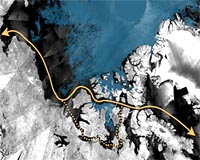| . |  |
. |
Durham NH (SPX) Jun 08, 2009 Scientists from around the world will convene at the University of New Hampshire to discuss key findings from the most ambitious effort ever undertaken to measure "short-lived" airborne pollutants in the Arctic and determine how they contribute in the near term to the dramatic changes underway in the vast, climate-sensitive region. The two-year international field campaign known as POLARCAT was conducted most intensively during two three-week periods last spring and summer and focused on the transport of pollutants into the Arctic from lower latitudes. One surprise discovery was that large-scale agricultural burning in Russia, Kazakhstan, China, the U.S., Canada, and the Ukraine is having a much greater impact than previously thought. A particular threat is posed by springtime burning - to remove crop residues for new planting or clear brush for grazing - because the black carbon or soot produced by the fires can lead to accelerated melting of snow and ice. Soot, which is produced through incomplete combustion of biomass and fossil fuels, may account for as much as 30 percent of Arctic warming to date, according to recent estimates. Soot can warm the surrounding air and, when deposited on ice and snow, absorb solar energy and add to the melting process. In addition to soot, other short-lived pollutants include ozone and methane. Although global warming is largely the result of excess accumulation of carbon dioxide, the Arctic is highly sensitive to short-lived pollutants. Forest fires, agricultural burning, primitive cookstoves, and diesel fuel are the primary sources of black carbon; oil and gas activities and landfills are major sources of methane. During the UNH workshop, a report by the Clean Air Task Force detailing some of the campaign's findings on agricultural burning and transport to the Arctic will be officially released. "Targeting these emissions offers a supplemental and parallel strategy to carbon dioxide reductions, with the advantage of a much faster temperature response, and the benefit of health risk reductions," says Ellen Baum, senior scientist of the Clean Air Task Force. "In addition, we have the know-how to control these pollutants today." The report notes that during April, at the beginning portion of the field campaign in Northern Alaska, aircraft-based researchers were surprised to find 50 smoke plumes originating from fires in Eurasia more than 3,000 miles away. Analysis of the plumes, combined with satellite images, revealed the smoke came from agricultural fires in Northern Kazakhstan-Southern Russia and from forest fires in Southern Siberia. The emissions from fires far outweighed those from fossil fuels, the report states. "These fires weren't part of our standard predictions, they weren't in our models," says Daniel Jacob, a professor of atmospheric chemistry and environmental engineering at Harvard. Jacob participated in a portion of the campaign known as ARCTAS, which used NASA's DC-8 "flying laboratory" to sample plumes of air over Arctic regions in Alaska and Canada. The international team of scientists used satellites, instrumented aircraft, ocean-going ships, and ground stations to track and analyze pollution transported into the region. UNH atmospheric chemist Jack Dibb of the Institute for the Study of Earth, Oceans, and Space was also on the DC-8. "We're in agreement that these short-lived pollutants are critical in the Arctic. This meeting is to discuss what we learned from this massive undertaking and what we as a scientific community can recommend to help address the problem," says Dibb. The work presented at the POLARCAT meeting will benefit the eight-country Arctic Council, which recently voted to jointly undertake efforts to reduce emissions of black carbon, ozone precursors, and methane in order to slow climate change and ice melt in the Arctic. The data will provide more robust results for governments to use in the development of mitigation efforts with the highest likelihood of benefiting Arctic climate. "Accelerated warming is unraveling the ecosystems of the Arctic region," says Brooks Yeager, executive vice president of Clean Air-Cool Planet. "Pollutants carried into the region help drive this unprecedented warming and melting, which makes this new science so very valuable, pinpointing as it does the sources and the solutions." Share This Article With Planet Earth
Related Links University of New Hampshire Beyond the Ice Age
 Unstated Assumptions Color Arctic Sovereignty Claims
Unstated Assumptions Color Arctic Sovereignty ClaimsOttawa, Canada (SPX) Jun 05, 2009 Settling the growing debate over ownership of Arctic Ocean resources is complicated by the fact that the various countries involved have different understandings of the geography of the place. Phil Steinberg, an associate professor in the Department of Geography at Florida State University in Tallahassee, says coming to terms with those divergent views is the first necessary step to ... read more |
|
| The content herein, unless otherwise known to be public domain, are Copyright 1995-2009 - SpaceDaily. AFP and UPI Wire Stories are copyright Agence France-Presse and United Press International. ESA Portal Reports are copyright European Space Agency. All NASA sourced material is public domain. Additional copyrights may apply in whole or part to other bona fide parties. Advertising does not imply endorsement,agreement or approval of any opinions, statements or information provided by SpaceDaily on any Web page published or hosted by SpaceDaily. Privacy Statement |